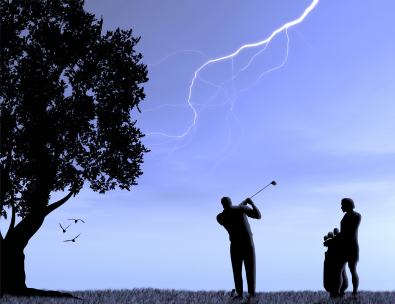
Each year, about 400 children and adults in the U.S. are struck by lightning while working outside, at sports events, on the beach, mountain climbing, mowing the lawn or during other outdoor activities. Several hundred more are left to cope with permanent disabilities. Here are some lightning safety rules to follow to avoid becoming a lightning statistic:
- Postpone activities promptly. Don't wait for rain. Many people take shelter from the rain, but most people struck by lightning are not in the rain! Go quickly inside a completely enclosed building, not a carport, open garage or covered patio. If no enclosed building is convenient, get inside a hard-topped all-metal vehicle. A cave is a good option outside but move as far as possible from the cave entrance.
- Take shelter at the lowest point. Lightning hits the tallest object. In the mountains if you are above tree line, you ARE the highest object around. Quickly get below tree line and get into a grove of small trees. Don't be the second tallest object during a lightning storm! Crouch down if you are in an exposed area on the balls of your feet with your arms covering your heat. Lying flat makes you more vulnerable to a strike.
- Keep an eye on the sky. Look for darkening skies, flashes of lightning, or increasing wind, which may be signs of an approaching thunderstorm.
- Listen for the sound of thunder. If you can hear thunder, go to a safe shelter immediately. Don't wait until the lighting arrives. It could be too late.
- Suspend games or practices. If you see or hear a thunderstorm coming or your hair stands on end, the game or practice should be immediately suspended for 30 minutes and everyone instructed to go inside to a sturdy building or car. Sturdy buildings are the safest place to be. Avoid sheds, picnic shelters, baseball dugouts, and bleachers. If no sturdy building is nearby, a hardtop vehicle with windows and doors closed will offer some protection. The steel frame of the vehicle provides some protection if you are not touching metal.
- Listen to NOAA Weather Radio. Coaches and other leaders should listen for a tone-alert feature during practice sessions and games.
- If you can't get to a shelter, stay away from trees. If there is no shelter, crouch in the open, keeping twice as far away from a tree as it is tall.
- Avoid leaning against vehicles. Get off bicycles and motorcycles.
- Get out of the water. It's a great conductor of electricity. Stay off the beach and out of small boats or canoes. If caught in a boat, crouch down in the center of the boat away from metal hardware. Swimming, wading, snorkeling and scuba diving are NOT safe. Lightning can strike the water and travel some distance beneath and away from its point of contact. Don't stand in puddles of water, even if wearing rubber boots.
- Avoid metal! Drop metal backpacks, baseball bats, lacrosse sticks, rakes, etc. stay away from clotheslines, fences, exposed sheds and electrically conductive elevated objects. Don't hold on to metal items such golf clubs, fishing rods, tennis rackets, baseball bats, lacrosse sticks or tools. Large metal objects can conduct lightning. Small metal objects can cause burns.
- Move away from a group of people. Stay several yards away from other people. Don't share a bleacher bench or huddle in a group
For more information visit the National Weather Service web site.
Revised May 25, 2011








